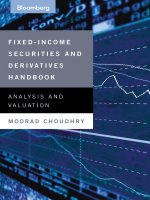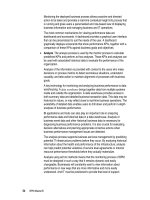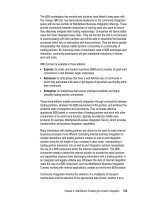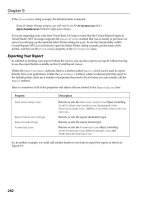Additional Praise for Fixed Income Securities Tools for Today’s Markets, 2nd Edition phần 1 docx
Bạn đang xem bản rút gọn của tài liệu. Xem và tải ngay bản đầy đủ của tài liệu tại đây (710.11 KB, 53 trang )
Additional Praise for
Fixed Income Securities:
Tools for Today’s Markets, 2nd Edition
“In my opinion, this edition of Tuckman’s book has no match in terms of
clarity, accessibility and applicability to today’s bond markets.”
—Vineer Bhansali, Ph.D.
Executive Vice President
Head of Portfolio Analytics
PIMCO
“Tuckman’s book is a must for the bookshelf of anyone interested in the
concepts of fixed income markets and their application. Throughout the
book, the basic concepts are illustrated with numerical examples that make
them easier to apply from a practical perspective.”
—Marti G. Subrahmanyam
Charles E. Merrill Professor of Finance, Economics
and International Business
Stern School of Business, New York University
John Wiley & Sons
Founded in 1807, John Wiley & Sons is the oldest independent publishing company in the United States. With offices in North America, Europe, Australia and
Asia, Wiley is globally committed to developing and marketing print and electronic products and services for our customers’ professional and personal knowledge and understanding.
The Wiley Finance series contains books written specifically for finance and investment professionals as well as sophisticated individual investors and their financial advisors. Book topics range from portfolio management to e-commerce,
risk management, financial engineering, valuation and financial instrument
analysis, as well as much more.
For a list of available titles, please visit our web site at www.WileyFinance.com.
Fixed Income
Securities
Tools for Today’s Markets
Second Edition
BRUCE TUCKMAN
John Wiley & Sons, Inc.
Copyright © 2002 by Bruce Tuckman. All rights reserved.
Published by John Wiley & Sons, Inc., Hoboken, New Jersey.
Published simultaneously in Canada.
No part of this publication may be reproduced, stored in a retrieval system, or
transmitted in any form or by any means, electronic, mechanical, photocopying,
recording, scanning, or otherwise, except as permitted under Section 107 or 108 of the
1976 United States Copyright Act, without either the prior written permission of the
Publisher, or authorization through payment of the appropriate per-copy fee to the
Copyright Clearance Center, Inc., 222 Rosewood Drive, Danvers, MA 01923,
978-750-8400, fax 978-750-4470, or on the web at www.copyright.com. Requests to
the Publisher for permission should be addressed to the Permissions Department,
John Wiley & Sons, Inc., 111 River Street, Hoboken, NJ 07030, 201-748-6011,
fax 201-748-6008, e-mail:
Limit of Liability/Disclaimer of Warranty: While the publisher and author have used
their best efforts in preparing this book, they make no representations or warranties
with respect to the accuracy or completeness of the contents of this book and
specifically disclaim any implied warranties of merchantability or fitness for a particular
purpose. No warranty may be created or extended by sales representatives or written
sales materials. The advice and strategies contained herein may not be suitable for your
situation. You should consult with a professional where appropriate. Neither the
publisher nor author shall be liable for any loss of profit or any other commercial
damages, including but not limited to special, incidental, consequential, or other
damages.
For general information on our other products and services, or technical support,
please contact our Customer Care Department within the United States at
800-762-2974, outside the United States at 317-572-3993 or fax 317-572-4002.
Wiley also publishes its books in a variety of electronic formats. Some content that
appears in print may not be available in electronic books.
Credit Suisse First Boston (CSFB) is not responsible for any statements or conclusions
herein, and no opinions, theories, or techniques presented herein in any way represent
the position of CSFB.
Library of Congress Cataloging-in-Publication Data:
Tuckman, Bruce.
Fixed income securities : tools for today’s market / Bruce Tuckman.—
2nd ed.
p. cm.—(Wiley finance series)
ISBN 0-471-06317-7 (cloth)
ISBN 0-471-06322-3 (paperback)
1. Fixed income securities. I. Title. II. Series.
HG4650 .T83 2002
332.63'2044—dc21
2002005425
Printed in the United States of America.
10 9 8 7 6 5 4 3 2 1
CONTENTS
INTRODUCTION
xiii
ACKNOWLEDGMENTS
xv
PART ONE
The Relative Pricing of Fixed Income Securities with Fixed Cash Flows
1
CHAPTER 1
Bond Prices, Discount Factors, and Arbitrage
3
The Time Value of Money 3
Treasury Bond Quotations 4
Discount Factors 6
The Law of One Price 8
Arbitrage and the Law of One Price 10
Treasury STRIPS 12
APPENDIX 1A
Deriving the Replicating Portfolio 17
APPENDIX 1B
APPLICATION: Treasury Triplets and High Coupon Bonds
CHAPTER 2
Bond Prices, Spot Rates, and Forward Rates
18
23
Semiannual Compounding 23
Spot Rates 25
Forward Rates 28
Maturity and Bond Price 32
Maturity and Bond Return 34
Treasury STRIPS, Continued 37
v
vi
CONTENTS
APPENDIX 2A
The Relation between Spot and Forward Rates and the Slope of the
Term Structure 38
CHAPTER 3
Yield-to-Maturity
41
Definition and Interpretation 41
Yield-to-Maturity and Spot Rates 46
Yield-to-Maturity and Relative Value: The Coupon Effect
Yield-to-Maturity and Realized Return 51
50
CHAPTER 4
Generalizations and Curve Fitting
53
Accrued Interest 53
Compounding Conventions 56
Yield and Compounding Conventions 59
Bad Days 60
Introduction to Curve Fitting 61
Piecewise Cubics 69
APPLICATION: Fitting the Term Structure in the U.S. Treasury Market
on February 15, 2001 71
TRADING CASE STUDY: A 7s-8s-9s Butterfly 77
APPENDIX 4A
Continuous Compounding 83
APPENDIX 4B
A Simple Cubic Spline 85
PART TWO
Measures of Price Sensitivity and Hedging
87
CHAPTER 5
One-Factor Measures of Price Sensitivity
89
DV01 91
A Hedging Example, Part I: Hedging a Call Option
95
vii
Contents
Duration 98
Convexity 101
A Hedging Example, Part II: A Short Convexity Position 103
Estimating Price Changes and Returns with DV01, Duration, and Convexity 105
Convexity in the Investment and Asset-Liability Management Contexts 108
Measuring the Price Sensitivity of Portfolios 109
A Hedging Example, Part III: The Negative Convexity of Callable Bonds 111
CHAPTER 6
Measures of Price Sensitivity Based on Parallel Yield Shifts
115
Yield-Based DV01 115
Modified and Macaulay Duration 119
Zero Coupon Bonds and a Reinterpretation of Duration 120
Par Bonds and Perpetuities 122
Duration, DV01, Maturity, and Coupon: A Graphical Analysis 124
Duration, DV01, and Yield 127
Yield-Based Convexity 127
Yield-Based Convexity of Zero Coupon Bonds 128
The Barbell versus the Bullet 129
CHAPTER 7
Key Rate and Bucket Exposures
Key Rate Shifts 134
Key Rate 01s and Key Rate Durations 135
Hedging with Key Rate Exposures 137
Choosing Key Rates 140
Bucket Shifts and Exposures 142
Immunization 147
Multi-Factor Exposures and Risk Management
133
147
CHAPTER 8
Regression-Based Hedging
Volatility-Weighted Hedging 150
One-Variable Regression-Based Hedging 153
Two-Variable Regression-Based Hedging 158
TRADING CASE STUDY: The Pricing of the 20-Year U.S. Treasury Sector
A Comment on Level Regressions 166
149
161
viii
CONTENTS
PART THREE
Term Structure Models
169
CHAPTER 9
The Science of Term Structure Models
171
Rate and Price Trees 171
Arbitrage Pricing of Derivatives 174
Risk-Neutral Pricing 177
Arbitrage Pricing in a Multi-Period Setting 179
Example: Pricing a CMT Swap 185
Reducing the Time Step 187
Fixed Income versus Equity Derivatives 190
CHAPTER 10
The Short-Rate Process and the Shape of the Term Structure
193
Expectations 194
Volatility and Convexity 196
Risk Premium 201
A Mathematical Description of Expectations, Convexity, and
Risk Premium 206
APPLICATION: Expectations, Convexity, and Risk Premium in the
U.S. Treasury Market on February 15, 2001 212
APPENDIX 10A
Proofs of Equations (10.19) and (10.25) 214
CHAPTER 11
The Art of Term Structure Models: Drift
219
Normally Distributed Rates, Zero Drift: Model 1 219
Drift and Risk Premium: Model 2 225
Time-Dependent Drift: The Ho-Lee Model 228
Desirability of Fitting to the Term Structure 229
Mean Reversion: The Vasicek (1977) Model 232
CHAPTER 12
The Art of Term Structure Models: Volatility and Distribution
Time-Dependent Volatility: Model 3 245
Volatility as a Function of the Short Rate: The Cox-Ingersoll-Ross
and Lognormal Models 248
245
ix
Contents
Tree for the Original Salomon Brothers Model 251
A Lognormal Model with Mean Reversion: The Black-Karasinski Model
Selected List of One-Factor Term Structure Models 255
APPENDIX 12A
Closed-Form Solutions for Spot Rates 257
CHAPTER 13
Multi-Factor Term Structure Models
Motivation from Principal Components 259
A Two-Factor Model 263
Tree Implementation 265
Properties of the Two-Factor Model 269
Other Two-Factor and Multi-Factor Modeling Approaches 274
APPENDIX 13A
Closed-Form Solution for Spot Rates in the Two-Factor Model
CHAPTER 14
Trading with Term Structure Models
253
259
275
277
Example Revisited: Pricing a CMT Swap 278
Option-Adjusted Spread 278
Profit and Loss (P&L) Attribution 280
P&L Attributions for a Position in the CMT Swap 283
TRADING CASE STUDY: Trading 2s-5s-10s in Swaps with a
Two-Factor Model 286
Fitting Model Parameters 295
Hedging to the Model versus Hedging to the Market 297
PART FOUR
Selected Securities
301
CHAPTER 15
Repo
303
Repurchase Agreements and Cash Management 303
Repurchase Agreements and Financing Long Positions 305
Reverse Repurchase Agreements and Short Positions 308
Carry 311
General Collateral and Specials 314
x
CONTENTS
Special Repo Rates and the Auction Cycle 316
Liquidity Premiums of Recent Issues 319
APPLICATION: Valuing a Bond Trading Special in Repo 321
APPLICATION: Disruption in the Specials Market after September 11, 2001
CHAPTER 16
Forward Contracts
Definitions 325
Forward Price of a Deposit or a Zero Coupon Bond 326
Using Forwards to Hedge Borrowing Costs or Loan Proceeds
Forward Price of a Coupon Bond 329
Forward Yield and Forward DV01 331
Forward Prices with Intermediate Coupon Payments 332
Value of a Forward Contract 335
Forward Prices in a Term Structure Model 336
325
328
CHAPTER 17
Eurodollar and Fed Funds Futures
LIBOR and Eurodollar Futures 339
Hedging with Eurodollar Futures 343
Tails: A Closer Look at Hedging with Futures 344
Futures on Prices in a Term Structure Model 347
Futures on Rates in a Term Structure Model 349
The Futures-Forward Difference 350
TED Spreads 355
APPLICATION: Trading TED Spreads 359
Fed Funds 362
Fed Funds Futures 364
APPLICATION: Fed Funds Contracts and Predicted Fed Action
APPENDIX 17A
Hedging to Dates Not Matching Fed Funds and Eurodollar
Futures Expirations 369
CHAPTER 18
Interest Rate Swaps
Swap Cash Flows 371
Valuation of Swaps 373
323
339
366
371
Contents
xi
Floating Rate Notes 374
Valuation of Swaps, Continued 376
Note on the Measurement of Fixed and Floating Interest Rate Risk 378
Swap Spreads 378
Major Uses of Interest Rate Swaps 381
Asset Swap Spreads and Asset Swaps 382
TRADING CASE STUDY: 30-Year FNMA Asset Swap Spreads 386
On the Credit Risk of Swap Agreements 388
APPENDIX 18A
TRADING CASE STUDY: Five-Year On-the-Run/Off-the-Run Spread
of Spreads 390
CHAPTER 19
Fixed Income Options
397
Definitions and Review 397
Pricing American and Bermudan Bond Options in a Term
Structure Model 400
APPLICATION: FNMA 6.25s of July 19, 2011, and the Pricing of
Callable Bonds 405
Graphical Analysis of Callable Bond Pricing 408
A Note on Yield-to-Call 411
Swaptions, Caps, and Floors 413
Quoting Prices with Volatility Measures in Fixed Income Options Markets 416
Smile and Skew 420
CHAPTER 20
Note and Bond Futures
Mechanics 423
Cost of Delivery and the Determination of the Final Settlement Price 426
Motivations for a Delivery Basket and Conversion Factors 428
Imperfection of Conversion Factors and the Delivery Option at Expiration 431
Gross and Net Basis 435
Quality Option before Delivery 438
Some Notes on Pricing the Quality Option in Term Structure Models 441
Measures of Rate Sensitivity 443
Timing Option 444
End-of-Month Option 445
TRADING CASE STUDY: November ’08 Basis into TYM0 446
423
xii
CONTENTS
CHAPTER 21
Mortgage-Backed Securities
Basic Mortgage Mathematics 455
Prepayment Option 459
Overview of Mortgage Pricing Models 464
Implementing Prepayment Models 467
Price-Rate Curve of a Mortgage Pass-Through 471
APPLICATION: Mortgage Hedging and the Directionality of Swap Spreads
Mortgage Derivatives, IOs, and POs 475
455
473
EXERCISES
479
REFERENCES AND SUGGESTIONS FOR FURTHER READING
497
INDEX
501
INTRODUCTION
he goal of this edition is the same as that of the first: to present the conceptual framework used for the pricing and hedging of fixed income securities in an intuitive and mathematically simple manner. But, in striving
to fulfil this goal, this edition substantially revises and expands the first.
Many concepts developed by expert practitioners and academics remain mysterious or only partially understood by many. Examples include
convexity, risk-neutral pricing, risk premium, mean reversion, the futuresforward effect, and the financing tail. While many books explain these and
other concepts quite elegantly, the largely mathematical presentations are
beyond the reach of much of the interested audience. This state of affairs is
particularly regrettable because the essential ideas developed in industry
and academics can be conveyed intuitively and by example. While this
book is quantitatively demanding, like the field of fixed income itself, the
level of mathematics has been confined mostly to simple algebra. On the
occasions when the calculus is invoked, the reader is escorted through the
equations, a term at a time, toward an understanding of the underlying
concepts.
The book is full of examples. These range from simple examples that
introduce ideas to the 15 detailed applications and trading case studies
showing how these ideas are applied in practice. This “spoonful of sugar”
approach makes the material easier to understand and more fun to study.
Equally important, it gives readers a sense of orders of magnitude. After
working to understand the coupon effect, for example, one should also
have a good idea of when the effect is large and when it is insignificant. In
a complex, competitive, and fast-moving field like fixed income, it is crucial to develop the ability to distinguish between issues that require immediate attention and those that may be reflected upon at leisure.
Part One of the book presents the relationships among bond prices,
spot rates, forward rates, and yields. The fundamental notion of arbitrage
pricing is introduced in the context of securities with fixed cash flows.
Part Two describes various ways to measure interest rate risks for the
T
xiii
xiv
INTRODUCTION
purpose of quantifying and hedging these risks. The chapters cover basic
and commonly used measures, like DV01, duration, and simple regressionbased measures, as well as several more sophisticated measures. These include measures based on pricing models, multi-factor measures, and
two-factor regression-based measures.
Part Three introduces the arbitrage-based, term structure models used
to price fixed income derivatives, that is, securities whose cash flows depend on the level of interest rates. Many well-known models are discussed,
like the Vasicek or Black-Karasinski models, but since there are many models in use and many more potential models, the chapters in this part have
two broader aims: First, to explain the roles of expectations, volatility, and
risk premium in the determination of the term structure and in the construction of term structure models; Second, to explain how the fundamental building blocks of term structure models, namely, drift, volatility
structure, and distribution, are assembled to create models with different
characteristics. Some multi-factor models are also discussed. Finally, this
part describes how term structure models are applied to trading and investment decisions.
Part Four uses the concepts of the first three parts to analyze several
major securities in fixed income markets. These are important subjects in
their own right: repurchase agreements, forwards, futures, options, swaps,
and mortgages. In addition, however, the exercise of using the fixed income
tool kit to analyze these securities in detail develops the skills required to
attack unfamiliar and challenging problems.
This book is meant to help current practitioners deepen their understanding of various subjects; to introduce newcomers to this complex field;
and to serve as a useful reference after an initial reading. As a result of
these multiple objectives, the book does mention certain subjects before
they are formally treated. For example, a relevant point about swaps may
be made in an early chapter even though swaps are not discussed in detail
until Chapter 18. Current practitioners and readers using the book as a reference will not find this a problem. Hopefully, with a willingness to take
some points on faith during a first reading or with the enterprise to use the
index, newcomers to the field will eventually appreciate this organization.
ACKNOWLEDGMENTS
thank Guillaume Gimonet, Andrew Kalotay, Vinay Pande, Fidelio Tata,
and especially Jeffrey Rosenbluth for extremely helpful discussions on
the subject matter of this book, and I thank Helen Edersheim for carefully
reviewing the manuscript. All errors are, of course, my own. I am indebted
to Bill Falloon at John Wiley & Sons for his support throughout the planning, writing, and production stages. Finally, I thank my wife Katherine
and my two boys, Teddy and P.J., for the sacrifices they made in allowing
me the time to write this book and for reminding me that the field of fixed
income is, after all, a very small part of life.
I
xv
PART
ONE
The Relative Pricing of
Fixed Income Securities
with Fixed Cash Flows
CHAPTER
1
Bond Prices, Discount
Factors, and Arbitrage
THE TIME VALUE OF MONEY
How much are people willing to pay today in order to receive $1,000 one
year from today? One person might be willing to pay up to $960 because
throwing a $960 party today would be as pleasurable as having to wait a
year before throwing a $1,000 party. Another person might be willing to
pay up to $950 because the enjoyment of a $950 stereo system starting
today is worth as much as enjoying a $1,000 stereo system starting one
year from today. Finally, a third person might be willing to pay up to
$940 because $940 invested in a business would generate $1,000 at the
end of a year. In all these cases people are willing to pay less than $1,000
today in order to receive $1,000 in a year. This is the principle of the time
value of money: Receiving a dollar in the future is not so good as receiving a dollar today. Similarly, paying a dollar in the future is better than
paying a dollar today.
While the three people in the examples are willing to pay different
amounts for $1,000 next year, there exists only one market price for this
$1,000. If that price turns out to be $950 then the first person will pay
$950 today to fund a $1,000 party in a year. The second person would be
indifferent between buying the $950 stereo system today and putting away
$950 to purchase the $1,000 stereo system next year. Finally, the third person would refuse to pay $950 for $1,000 in a year because the business can
transform $940 today into $1,000 over the year. In fact, it is the collection
of these individual decisions that determines the market price for $1,000
next year in the first place.
Quantifying the time value of money is certainly not restricted to the
3
4
BOND PRICES, DISCOUNT FACTORS, AND ARBITRAGE
pricing of $1,000 to be received in one year. What is the price of $500 to
be received in 10 years? What is the price of $50 a year for the next 30
years? More generally, what is the price of a fixed income security that provides a particular set of cash flows?
This chapter demonstrates how to extract the time value of money implicit in U.S. Treasury bond prices. While investors may ultimately choose
to disagree with these market prices, viewing some securities as undervalued and some as overvalued, they should first process and understand all
of the information contained in market prices. It should be noted that measures of the time value of money are often extracted from securities other
than U.S. Treasuries (e.g., U.S. agency debt, government debt outside the
United States, and interest rate swaps in a variety of currencies). Since the
financial principles and calculations employed are similar across all these
markets, there is little lost in considering U.S. Treasuries alone in Part One.
The discussion to follow assumes that securities are default-free, meaning that any and all promised payments will certainly be made. This is
quite a good assumption with respect to bonds sold by the U.S. Treasury
but is far less reasonable an assumption with respect to financially weak
corporations that may very well default on their obligations to pay. In any
case, investors interested in pricing corporate debt must first understand
how to value certain or default-free payments. The value of $50 promised
by a corporation can be thought of as the value of a certain payment of
$50 minus a default penalty. In this sense, the time value of money implied
by default-free obligations is a foundation for pricing securities with credit
risk, that is, with a reasonable likelihood of default.
TREASURY BOND QUOTATIONS
The cash flows from most Treasury bonds are completely defined by face
value or par value, coupon rate, and maturity date. For example, buying a
Treasury bond with a $10,000 face value, a coupon rate of 51/4%, and a
maturity date of August 15, 2003, entitles the owner to an interest payment of $10,000×51/4% or $525 every year until August 15, 2003, and a
$10,000 principal payment on that date. By convention, however, the $525
due each year is paid semiannually, that is, in installments of $262.50
every six months. In fact, in August 1998 the Treasury did sell a bond with
this coupon and maturity; Figure 1.1 illustrates the cash paid in the past
and to be paid in the future on $10,000 face amount of this bond.
5
Treasury Bond Quotations
$10,262.50
$262.50
8/15/98
$262.50
$262.50
$262.50
$262.50
$262.50
$262.50
$262.50
$262.50
2/15/99
8/15/99
2/15/00
8/15/00
2/15/01
8/15/01
2/15/02
8/15/02
2/15/03
8/15/03
FIGURE 1.1 The Cash Flows of the 5.25s of August 15, 2003
An investor purchasing a Treasury bond on a particular date must usually pay for the bond on the following business day. Similarly, the investor
selling the bond on that date must usually deliver the bond on the following business day. The practice of delivery or settlement one day after a
transaction is known as T+1 settle. Table 1.1 reports the prices of several
Treasury bonds at the close of business on February 14, 2001, for settlement on February 15, 2001.
The bonds in Table 1.1 were chosen because they pay coupons in even
six-month intervals from the settlement date.1 The columns of the table
give the coupon rate, the maturity date, and the price. Note that prices are
expressed as a percent of face value and that numbers after the hyphens denote 32nds, often called ticks. In fact, by convention, whenever a dollar or
other currency symbol does not appear, a price should be interpreted as a
TABLE 1.1 Selected Treasury Bond Prices for Settlement
on February 15, 2001
Coupon
Maturity
Price
7.875%
14.250%
6.375%
6.250%
5.250%
8/15/01
2/15/02
8/15/02
2/15/03
8/15/03
101-123/4
108-31+
102-5
102-181/8
100-27
1
Chapter 4 will generalize the discussion of Chapters 1 to 3 to bonds that pay
coupons and principal on any set of dates.
6
BOND PRICES, DISCOUNT FACTORS, AND ARBITRAGE
percent of face value. Hence, for the 77/8s of August 15, 2001, the price of
101-123/4 means 101+12.75/32% of face value or approximately 101.3984%.
Selling $10,000 face of this bond would generate $10,000×1.013984 or
$10,139.84. For the 141/4s of February 15, 2002, the symbol “+” denotes
half a tick. Thus the quote of 108-31+ would mean 108+31.5/32.
DISCOUNT FACTORS
The discount factor for a particular term gives the value today, or the present value of one unit of currency to be received at the end of that term.
The discount factor for t years is written d(t). So, for example, if
d(.5)=.97557, the present value of $1 to be received in six months is
97.557 cents. Continuing with this example, one can price a security that
pays $105 six months from now. Since $1 to be received in six months is
worth $.97557 today, $105 to be received in six months is worth
.97557×$105 or $102.43.2
Discount factors can be used to compute future values as well as present values. Since $.97557 invested today grows to $1 in six months, $1 invested today grows to $1/d(.5) or $1/.97557 or $1.025 in six months.
Therefore $1/d(.5) is the future value of $1 invested for six months.
Since Treasury bonds promise future cash flows, discount factors can
be extracted from Treasury bond prices. According to the first row of
Table 1.1, the value of the 77/8s due August 15, 2001, is 101-123/4. Furthermore, since the bond matures in six months, on August 15, 2001, it
will make the last interest payment of half of 77/8 or 3.9375 plus the principal payment of 100 for a total of 103.9375 on that date. Therefore, the
present value of this 103.9375 is 101-123/4. Mathematically expressed in
terms of discount factors,
101 + 12 3 4 / 32 = 103.9375d(.5)
(1.1)
Solving reveals that d(.5) = .97557.
2
For easy reading prices throughout this book are often rounded. Calculations,
however, are usually carried to greater precision.
7
Discount Factors
The discount factor for cash flows to be received in one year can be
found from the next bond in Table 1.1, the 141/4s due February 15, 2002.
Payments from this bond are an interest payment of half of 141/4 or 7.125
in six months, and an interest and principal payment of 7.125+100 or
107.125 in one year. The present value of these payments may be obtained
by multiplying the six-month payment by d(.5) and the one-year payment
by d(1). Finally, since the present value of the bond’s payments should
equal the bond’s price of 108-31+, it must be that
108 + 31.5 / 32 = 7.125d(.5) + 107.125d(1)
(1.2)
Knowing that d(.5) = .97557 from equation (1.1), equation (1.2) can be
solved for d(1) to reveal that d(1) = .95247.
Continuing in this fashion, the prices in Table 1.1 can be used to solve
for discount factors, in six-month intervals, out to two and one-half years.
The resulting values are given in Table 1.2. Because of the time value of
money, discount factors fall with maturity. The longer the payment of $1 is
delayed, the less it is worth today.
Applying techniques to be described in Chapter 4, Figure 1.2 graphs
the collection of discount factors, or the discount function for settlement
on February 15, 2001. It is clear from this figure as well that discount factors fall with maturity. Note how substantially discounting lowers the
value of $1 to be received in the distant future. According to the graph, $1
to be received in 30 years is worth about 19 cents today.
TABLE 1.2 Discount Factors
Derived from Bond Prices
Given in Table 1.1
Time to
Maturity
Discount
Factor
0.5
1
1.5
2
2.5
0.97557
0.95247
0.93045
0.90796
0.88630
8
BOND PRICES, DISCOUNT FACTORS, AND ARBITRAGE
1
0.9
0.8
Discount Factor
0.7
0.6
0.5
0.4
0.3
0.2
0.1
0
0
5
10
15
Term
20
25
30
FIGURE 1.2 The Discount Function in the Treasury Market on February 15, 2001
THE LAW OF ONE PRICE
In the previous section the value of d(.5) derived from the 77/8s of August
15, 2001, is used to discount the first coupon payment of the 141/4s of February 15, 2002. This procedure implicitly assumes that d(.5) is the same
for these two securities or, in other words, that the value of $1 to be received in six months does not depend on where that dollar comes from.
This assumption is a special case of the law of one price which states that,
absent confounding factors (e.g., liquidity, special financing rates,3 taxes,
credit risk), two securities (or portfolios of securities) with exactly the same
cash flows should sell for the same price.
The law of one price certainly makes economic sense. An investor
should not care whether $1 on a particular date comes from one bond or
another. More generally, fixing a set of cash flows to be received on any set
of dates, an investor should not care about how those cash flows were assembled from traded securities. Therefore, it is reasonable to assume that
3
See Chapter 15.









